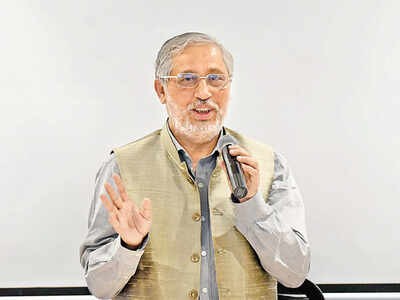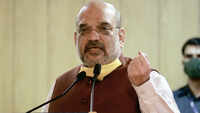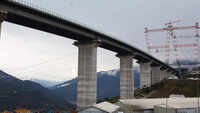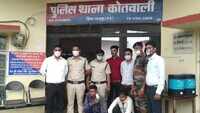
NEW DELHI: The government has just unveiled the National Education Policy (NEP) after 34 years. Professor Anil Sahasrabudhe, the chairman of the AICTE (All India Council for Technical Education) has played a role in its development, having been part of the negotiations and its evolution to its current form. He spoke to Professor Deepak Garg of Bennett University to address some of the questions in the minds of the stakeholders. Excerpts:
Q. Dear Prof. Sahasrabudhe, thanks for agreeing for this online Interview to answer some of the questions in the minds of the stakeholders.
A. Thank you, Prof. Deepak Garg. It is always pleasure talking to the leaders in education and technology. It is nice to know that you have gone through the NEP in detail and challenges in front of us in its implementation. I will be happy to answer your queries.
Q. Do you envision that NEP can help India break into Top Three economies in next 10 years. If we corelate it with Quality workforce and Innovation Culture, then It may come down to that at least five of our institutions break into top 50 of the world and many others progressing significantly from their current levels.
A. Yes, it is certainly possible. Starting from the vision of 5 Trillion economy on one side and Atmanirbhar Bharat on the other, set by the Government, the National Education Policy has come at the right time to catapult creating quality institutions, innovation culture and a highly skilled workforce. However, what is needed is to put in a robust system giving autonomy to institutions and focus on funding to the institutes, faculty training programs for both inspiring them and providing emerging technology inputs. Hence what is important is how all types of institutes and universities are given equal importance, autonomy and space for expansion and excellence, funding wherever required for research. We will support the idea that these institutes collaborate with each other depending on strengths of respective universities and solve the problems of the society and make India a developed nation, with more than 50% GER in the next 15 years, and how at least 10-15 institutes of India appear in global top 100 rankings.
Q. Equity and inclusion will be key to the success of the NEP, so that it does not serve the resourceful class of the society. How you think that quality education can be given to all the sections of the society without compromise. Probably vocational education will play a major role here.
A. Equity and inclusion have been important parameters while designing NEP. Quality education can be provided to all those who are keen to undergo higher education. There could be different models for this. Charging a little higher fee to the affordable class and giving concessions and rebates to those whose incomes are less. Alternately, one can provide special scholarship to those who cannot afford with attached work (that is work integrated program). Another model could be to provide interest free loans to all needy students. Lastly, appealing to alumni of the institute or CSR funding through nearby industry can empower such less privileged people. Due emphasis on vocational education is necessary so that those who are looking for early jobs should spend their resources on acquiring right skills at right time.
Q. Light but tight regulation is very relative term and can be interpreted in both ways by the bureaucracy. Can we consider it stick and carrot approach or you would like to come up with some other analogy?
A. Although it appears to be a carrot and a stick policy, it indeed is not. Light means there will not be Inspection Raj and hence the institutes shall not be burdened by visits of inspectors/experts to check and verify the facilities available etc. Tight means institutes shall be asked to disclose the available facilities on their website. It will enable transparency by checking the data that institution meets the minimum needed infrastructure. If the institute is found to have violated the same by giving false information, there would be strong penalty which will act as deterrent not only to the penalized institute, but other institutes watching from the sidelines.
Q. Institutional Restructuring has been taken up as a major agenda item in the NEP. It has the potential to disrupt the system as more than half of the institutions are having inadequate resources and student numbers. How you think it will be carried out and the challenges involved.
A. There could be a big shake up or disruption or transformation, whatever we may call. The unviable institutes shall not be able to manage the two ends meet and hence may close. Some of the colleges would possibly coalesce and share their infrastructure, faculty etc.; thereby such institutes shall become viable. There could be mentoring support for institutes to improve their processes, quality and get them through the accreditation cycle.
Q. People are very much excited about the multiple exit options with in their 3- or 4-year undergraduate degree. If we combine it with Academic bank of credit, it becomes an attractive combination. Curriculum design and Technology infrastructure are going to be key challenges in implementation. How well we are prepared for these changes.
A. This is a big-ticket change. There were many examples in the past where individuals could not continue their education because of several compulsions like family not able to afford, sudden death of a earning family member, sudden accident and hence loss of a year or two, even transfer of parent and hence family being not able to support extra expenses because of additional burden of expenditure etc. Hence this policy of any time exit, and re-entry later will empower such students and permit them to earn, save and return for completing their education.
The banking of credits is another feature, wherein one can get some credits from one university, another set of credits from a second university and complete the credit requirements for a degree from a third university. Students of Physics may do courses in Music, students of Engineering may do courses in Painting etc. Of course, there would be a need for regulations, making people aware of this, and challenges in overcoming old dogmatic views in the universities etc. As far as 3/4-year degree programmes are concerned, one can get a nominal degree in three years, but by continuing one more year, one may earn an honors degree, an additional minor degree etc.
Q. It has been said that select foreign Universities will be permitted to operate in India. Is there space in the policy for setting up joint campuses with Indian Universities. Will that be the preferred model? Do you also foresee a possibility of brand of Indian Universities further going down if independent campuses are set up by some of the top Universities?
A. The entry of some good foreign universities will bring in competition on one side and best practices of those universities in other Indian universities. Secondly many Indian students would get a degree of a foreign university by being in India at an affordable price. There could also be opportunities to set up universities in collaboration with foreign universities. The only issue which needs to be addressed is the policy of not for profit philosophy and how such foreign universities can still be attracted. Many Indian institutions will rise to the occasion to improve themselves which will make it a win-win situation.
Q. Current system is being run by Babus in the traditional way. NEP mentions about IES cadre. How you think it can revolutionize the leadership space in education sector of the country.
A. The education should always be left to be addressed by educationists, academics with full autonomy. The signs of this have already been visible whether in the form of graded autonomy (Category-1 and 2) with NAAC/NBA scores and selection of institutions of eminence, 10 in public sector and 10 in private sector. The pace of this change will only get accelerated. The academic leadership development programs already under way too will accentuate this process.
Q. Can you let us go through some of your experiences in this journey of NEP in last five years. There must have been a lot of resistance from various groups.
A. I did not see much resistance from any stakeholder as far as most of the reforms are concerned, except the philosophy of a single regulator for higher education. Of course, medicine and law have been exempted from this. There are distinct advantages with one single apex body taking care of all higher education institutions to avoid multiplicity of regulatory bodies with differing norms of these bodies, and institutes facing difficulties in satisfying all of them. E.g. A deemed university running a technical program such as architecture was answerable to UGC, AICTE and Council of Architecture. This overlap will be avoided. There are 4 different councils recommended under the overarching Higher Education Commission of India, one each for regulation, funding, accreditation and setting quality standards.
Q. Private Institutions like Bennett University has taken many initiatives in the last four years in line with the vision of the NEP. Flexible programs have been started with Majors, Minors, Specializations in niche areas, Open electives, Audit courses etc. There have been major tie-ups with Industry and foreign Universities. It has been able to position itself with nationwide initiative of futuristic technologies like leadingindia.ai How you envision the role of such institutions in the nation building on the lines of NEP.
A. Nation building is a duty of every citizen, not just the Government or the political class. Be it industry, philanthropist organizations or individuals, each have their role. Hence private institutions like Bennet University or IIITs under PPP mode or state government universities, and centrally funded universities or IITs, NITs, IIMs, IISERs etc., each have a role in national development. It is reassuring that Bennett University is taking a lead in innovating flexible pedagogy and ushering in initiating courses in latest technologies. It is satisfying that during my interaction with Institutions across the country in last five years, Significant number of such institutions are coming up very fast to meet the expectations of 130 Crore people of the country and match their education standards to the best in the world.
In conclusion, I would like to say that NEP will pave the way for the requisite changes that were necessary from last few decades and usher in meeting the expectations of millennial learners. It has become possible due to the resolute leadership of the country.
Q. Dear Prof. Sahasrabudhe, thanks for agreeing for this online Interview to answer some of the questions in the minds of the stakeholders.
A. Thank you, Prof. Deepak Garg. It is always pleasure talking to the leaders in education and technology. It is nice to know that you have gone through the NEP in detail and challenges in front of us in its implementation. I will be happy to answer your queries.
Q. Do you envision that NEP can help India break into Top Three economies in next 10 years. If we corelate it with Quality workforce and Innovation Culture, then It may come down to that at least five of our institutions break into top 50 of the world and many others progressing significantly from their current levels.
A. Yes, it is certainly possible. Starting from the vision of 5 Trillion economy on one side and Atmanirbhar Bharat on the other, set by the Government, the National Education Policy has come at the right time to catapult creating quality institutions, innovation culture and a highly skilled workforce. However, what is needed is to put in a robust system giving autonomy to institutions and focus on funding to the institutes, faculty training programs for both inspiring them and providing emerging technology inputs. Hence what is important is how all types of institutes and universities are given equal importance, autonomy and space for expansion and excellence, funding wherever required for research. We will support the idea that these institutes collaborate with each other depending on strengths of respective universities and solve the problems of the society and make India a developed nation, with more than 50% GER in the next 15 years, and how at least 10-15 institutes of India appear in global top 100 rankings.
Q. Equity and inclusion will be key to the success of the NEP, so that it does not serve the resourceful class of the society. How you think that quality education can be given to all the sections of the society without compromise. Probably vocational education will play a major role here.
A. Equity and inclusion have been important parameters while designing NEP. Quality education can be provided to all those who are keen to undergo higher education. There could be different models for this. Charging a little higher fee to the affordable class and giving concessions and rebates to those whose incomes are less. Alternately, one can provide special scholarship to those who cannot afford with attached work (that is work integrated program). Another model could be to provide interest free loans to all needy students. Lastly, appealing to alumni of the institute or CSR funding through nearby industry can empower such less privileged people. Due emphasis on vocational education is necessary so that those who are looking for early jobs should spend their resources on acquiring right skills at right time.
Q. Light but tight regulation is very relative term and can be interpreted in both ways by the bureaucracy. Can we consider it stick and carrot approach or you would like to come up with some other analogy?
A. Although it appears to be a carrot and a stick policy, it indeed is not. Light means there will not be Inspection Raj and hence the institutes shall not be burdened by visits of inspectors/experts to check and verify the facilities available etc. Tight means institutes shall be asked to disclose the available facilities on their website. It will enable transparency by checking the data that institution meets the minimum needed infrastructure. If the institute is found to have violated the same by giving false information, there would be strong penalty which will act as deterrent not only to the penalized institute, but other institutes watching from the sidelines.
Q. Institutional Restructuring has been taken up as a major agenda item in the NEP. It has the potential to disrupt the system as more than half of the institutions are having inadequate resources and student numbers. How you think it will be carried out and the challenges involved.
A. There could be a big shake up or disruption or transformation, whatever we may call. The unviable institutes shall not be able to manage the two ends meet and hence may close. Some of the colleges would possibly coalesce and share their infrastructure, faculty etc.; thereby such institutes shall become viable. There could be mentoring support for institutes to improve their processes, quality and get them through the accreditation cycle.
Q. People are very much excited about the multiple exit options with in their 3- or 4-year undergraduate degree. If we combine it with Academic bank of credit, it becomes an attractive combination. Curriculum design and Technology infrastructure are going to be key challenges in implementation. How well we are prepared for these changes.
A. This is a big-ticket change. There were many examples in the past where individuals could not continue their education because of several compulsions like family not able to afford, sudden death of a earning family member, sudden accident and hence loss of a year or two, even transfer of parent and hence family being not able to support extra expenses because of additional burden of expenditure etc. Hence this policy of any time exit, and re-entry later will empower such students and permit them to earn, save and return for completing their education.
The banking of credits is another feature, wherein one can get some credits from one university, another set of credits from a second university and complete the credit requirements for a degree from a third university. Students of Physics may do courses in Music, students of Engineering may do courses in Painting etc. Of course, there would be a need for regulations, making people aware of this, and challenges in overcoming old dogmatic views in the universities etc. As far as 3/4-year degree programmes are concerned, one can get a nominal degree in three years, but by continuing one more year, one may earn an honors degree, an additional minor degree etc.
Q. It has been said that select foreign Universities will be permitted to operate in India. Is there space in the policy for setting up joint campuses with Indian Universities. Will that be the preferred model? Do you also foresee a possibility of brand of Indian Universities further going down if independent campuses are set up by some of the top Universities?
A. The entry of some good foreign universities will bring in competition on one side and best practices of those universities in other Indian universities. Secondly many Indian students would get a degree of a foreign university by being in India at an affordable price. There could also be opportunities to set up universities in collaboration with foreign universities. The only issue which needs to be addressed is the policy of not for profit philosophy and how such foreign universities can still be attracted. Many Indian institutions will rise to the occasion to improve themselves which will make it a win-win situation.
Q. Current system is being run by Babus in the traditional way. NEP mentions about IES cadre. How you think it can revolutionize the leadership space in education sector of the country.
A. The education should always be left to be addressed by educationists, academics with full autonomy. The signs of this have already been visible whether in the form of graded autonomy (Category-1 and 2) with NAAC/NBA scores and selection of institutions of eminence, 10 in public sector and 10 in private sector. The pace of this change will only get accelerated. The academic leadership development programs already under way too will accentuate this process.
Q. Can you let us go through some of your experiences in this journey of NEP in last five years. There must have been a lot of resistance from various groups.
A. I did not see much resistance from any stakeholder as far as most of the reforms are concerned, except the philosophy of a single regulator for higher education. Of course, medicine and law have been exempted from this. There are distinct advantages with one single apex body taking care of all higher education institutions to avoid multiplicity of regulatory bodies with differing norms of these bodies, and institutes facing difficulties in satisfying all of them. E.g. A deemed university running a technical program such as architecture was answerable to UGC, AICTE and Council of Architecture. This overlap will be avoided. There are 4 different councils recommended under the overarching Higher Education Commission of India, one each for regulation, funding, accreditation and setting quality standards.
Q. Private Institutions like Bennett University has taken many initiatives in the last four years in line with the vision of the NEP. Flexible programs have been started with Majors, Minors, Specializations in niche areas, Open electives, Audit courses etc. There have been major tie-ups with Industry and foreign Universities. It has been able to position itself with nationwide initiative of futuristic technologies like leadingindia.ai How you envision the role of such institutions in the nation building on the lines of NEP.
A. Nation building is a duty of every citizen, not just the Government or the political class. Be it industry, philanthropist organizations or individuals, each have their role. Hence private institutions like Bennet University or IIITs under PPP mode or state government universities, and centrally funded universities or IITs, NITs, IIMs, IISERs etc., each have a role in national development. It is reassuring that Bennett University is taking a lead in innovating flexible pedagogy and ushering in initiating courses in latest technologies. It is satisfying that during my interaction with Institutions across the country in last five years, Significant number of such institutions are coming up very fast to meet the expectations of 130 Crore people of the country and match their education standards to the best in the world.
In conclusion, I would like to say that NEP will pave the way for the requisite changes that were necessary from last few decades and usher in meeting the expectations of millennial learners. It has become possible due to the resolute leadership of the country.
Download
The Times of India News App for Latest India News

Coronavirus outbreak
Trending Topics
LATEST VIDEOS
India
 Covid-19: Fresh guidelines for international passengers out
Covid-19: Fresh guidelines for international passengers out  Centre asks states, UTs to allow hospitalised Covid patients use smartphones to interact with kin
Centre asks states, UTs to allow hospitalised Covid patients use smartphones to interact with kin  Union home minister Amit Shah tests Covid-19 positive
Union home minister Amit Shah tests Covid-19 positive  World's highest, Chenab rail bridge to connect Kashmir with rest of India by 2022
World's highest, Chenab rail bridge to connect Kashmir with rest of India by 2022  Kin carry pregnant woman on makeshift basket to reach ambulance
Kin carry pregnant woman on makeshift basket to reach ambulance  2 arrested for allegedly killing friend in MP’s Shajapur
2 arrested for allegedly killing friend in MP’s Shajapur
More from TOI
Navbharat Times
Featured Today in Travel
Quick Links
Coronavirus in MumbaiCoronavirus in KolkataCoronavirus in HyderabadCoronavirus in DelhiCoronavirus in BangaloreCoronavirus symptomsCoronavirus in IndiaWhat is CoronavirusCoronavirus NewsSolar EclipseNPRWhat is NRCCAB BillCAB and NRCRTI BillPodcast newsLok SabhaShiv SenaYSRCPCongressBJP newsUIDAIIndian ArmyISRO newsSupreme Court
Get the app



